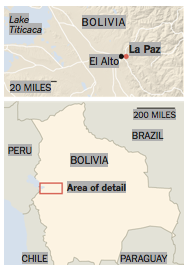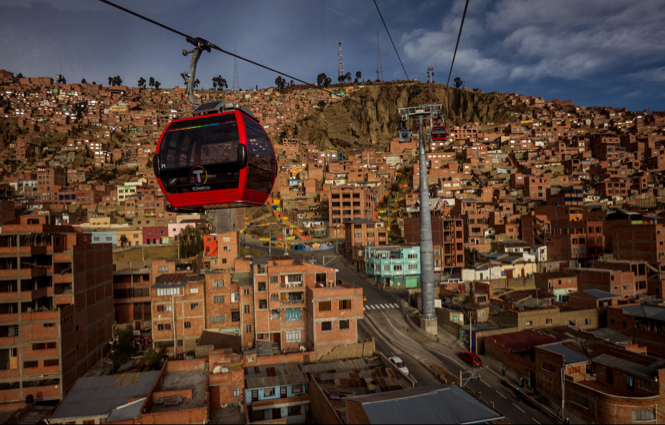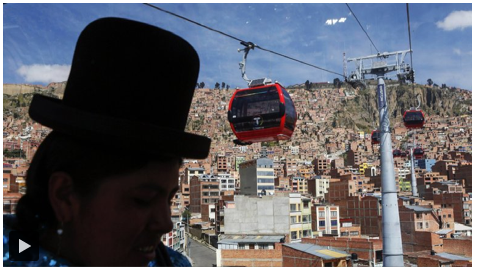(To see Video go to original story and click on picture.) Bolivia's Subway in the Sky For many Bolivians, the Teleférico is a symbol that the country has arrived. Opened in May, its two other sections will arrive conveniently as President Evo Morales seeks a third term.
With Subway in the Sky, Valley Meets Plateau
August 16, 2014 - New York Times
By WILLIAM NEUMAN
LA PAZ and EL ALTO, Bolivia — In these two cities, geography and rank stand in inverse relation. La Paz — the seat of government, old money and a lighter-skinned elite — sits in a valley. Above it on a high plateau is the frenetic city of El Alto: poorer, younger and generally darker-skinned. La Paz has always looked down on its upstart younger sibling above.
Now, that relationship is being challenged, and this urban Möbius strip, where down is up and up is down, is getting a new twist. A mass-transit aerial cable-car system, a cross between a ski gondola and an elevated train, is being installed to better connect them, chipping away at the physical barriers and possibly some of the psychological ones.
The first line in the system, stretching from an area near the center of La Paz to just beyond the lip of the plateau into El Alto, began carrying riders on May 31. Another line is expected to go into operation in September, and a third the next month — just in time for an election on Oct. 12, in which President Evo Morales is running for a third term.
Mr. Morales, who ordered the construction of the cable-car system, recently announced that he would build five more lines. It is part of a master plan that Cesar Dockweiler, the general coordinator of the project, said could eventually include up to 18 lines: stretching deep down the valley into La Paz's Zona Sur, or Southern Zone, where the wealthiest live, and far across the plateau, home to some of El Alto's poorest.
(below) Minibuses in traffic in El Alto. A cable-car ride will cost about twice as much, but some commuters say the convenience is worth it. Meridith Kohut for The New York Times

Bolivia, South America's poorest country, recently launched its first communications satellite to much fanfare about the country's progress. But many Bolivians have embraced the cable cars, closer to the ground, with more sustained enthusiasm as a modern and technological wonder.
The first line, known as the red line, carried two million passengers in its first 51 days of operation, which Mr. Dockweiler said was beyond the most optimistic projections. Some riders are commuters, but many have flocked to the line out of curiosity. It has become a sightseeing attraction for its novelty and for its sweeping views of La Paz and the surrounding mountains. The heaviest ridership is on Thursdays and Sundays, when a sprawling open-air market fills the streets of El Alto.
"It's a wonder," said Carlos Flores, 60, a printer, standing in a long line to board a cable car on a recent Sunday at La Paz's Central Station (Estación Central in Spanish, or Taypi Uta in Aymara, the predominant indigenous language in El Alto). Referring to one of his country's natural marvels, Mr. Flores said, "We say that Lake Titicaca is a wonder, and now we have another one."
Much as the subway system changed New York in the early 20th century, the cable-car system has the potential to transform La Paz and El Alto, connecting distant neighborhoods to the city center, raising real estate values, slashing commute times and altering social relations.

"People in El Alto are more guarded and more timid," said Leonidas Sánchez, 45, a school administrator from El Alto, riding down into La Paz one recent morning. "We are timid because we have a different skin color, and we live in different types of houses, and we do different kinds of work compared to the people of the Zona Sur. There has always been a relation of respect and even fear with those people."
Mr. Sánchez said that if he sat next to lighter-skinned people from the La Paz elite in a cable car, he would feel obligated to give them more space. While the election of Mr. Morales, an indigenous former coca farmer from a poor background, in 2005 has gone a long way toward changing such attitudes, Mr. Sánchez said the cable cars could help break them down further.
"I think that relationship of superiority will change, because we will express ourselves, and they will get to know us, and we will get to know them," he said.
In broad terms, La Paz is more Western and El Alto more indigenous. La Paz is more urban; El Alto is full of migrants from the countryside who retain their small-town ways. Spanish is spoken in La Paz; in El Alto, Aymara is heard at least as often. La Paz has its banks and a few fancy restaurants, while the center of El Alto's economic life is the twice-a-week street market where the smell of fried pork hangs thickly in the air. La Paz's rich live discreetly behind high walls; El Alto's rich live in ostentatious, brightly colored homes built over family stores.
(below) Much as the subway system changed New York in the early 20th century, Bolivia's mass-transit cable cars have the potential to transform La Paz, the capital, and neighboring El Alto. Meridith Kohut for The New York Times

"La Paz and El Alto have a different logic of life," said Luis Cayujra, 40, a lawyer from La Paz, who was waiting in line, camera in hand, to board a cable car for a ride up the slope to El Alto.
"I have friends that have either never been to El Alto or are afraid to go," Mr. Cayujra said. Now, he said, "Lots of young people will be able to explore the complex world of El Alto: the culture, the economy, the social forms, the architecture."
Traveling from El Alto on a frigid winter morning, the cable cars move over rooftops beneath a brilliant blue sky, the massive snow peak of Illimani ahead.
At night, the orange and white lights of La Paz spread out beneath riders like stars filling the valley, undulating with its contours.
Benjamin Limachi, 28, a jewelry maker who lives in El Alto, said he liked to take his girlfriend for rides at night, when they could sit alone in a car and take in the romantic view.
"It's very different to look from above and see how pretty La Paz is," Mr. Limachi said. "It's like flying in an airplane at low altitude."
Other cities, like Medellín, Colombia, and Caracas, Venezuela, have put in cable cars to reach some isolated hilltop neighborhoods. But nowhere else have cable cars been envisioned as the backbone of a mass-transit system, as in La Paz, said Torsten Bäuerlen, a manager at Doppelmayr, the Austrian company that is building the first three lines.
La Paz, the world's highest capital at about 12,000 feet above sea level, is different from most other cities. It spills down the slopes of a steep valley, making a subway or other train system impractical, and buses are subject to the heavy traffic that often gridlocks both cities.
"For us, the solution has been to build, quite literally, a subway in the air," said Mr. Dockweiler, the project coordinator.
A ride costs about 44 cents, as much as double the cost of the packed minibuses that clog the streets. But at least some commuters are willing to pay more to save time, and for the added comfort. The minibuses are reviled for being dirty and overcrowded, with drivers who often are rude, charge above the established fare and refuse to pick up older riders or people with children.
The $234 million price tag for the first three lines was paid virtually in cash, from the vast trove of hard currency that the country's Central Bank has amassed during several years of impressive economic growth fueled largely by the sale of natural gas to neighboring Brazil and Argentina. That in itself is a sign of the changes going on here.
"Before, to invest and carry out this type of project, the Bolivian government had to turn to outside financing," Mr. Dockweiler said. "When we opened the red line, people felt proud. And now Bolivians believe in themselves, believe in their ability to develop, in the country's chances to become greater."
The government sees the cable-car system as a way to draw La Paz and El Alto closer together, advertising it with slogans like "Uniting our lives" and "A meeting place."
"The thread of the cable car will permit a dialogue between the two cultures, a connection," said René Pereira, director of the school of social science at San Andrés University in La Paz. "And that is going to break down borders, and we will probably start to seriously reconsider the reality that is Bolivia."
